2003 PONTIAC GRAND PRIX child restraint
[x] Cancel search: child restraintPage 2 of 378

The 2003 Pontiac Grand Prix Owner Manual a
Seats and Restpaint Systems ........................... ? -1
Front Seats ............................................... 1-2
Safety Belts
.............................................. 1-7
Child Restraints
....................................... 1-29
Supplemental Restraint System
(SRS) ......... 1-51
Restraint System Check
............................ 1-58
Keys
........................................................ 2-3
Doors and Locks
....................................... 2-8
Windows
................................................. 2-1 3
Theft-Deterrent Systems
............................ 2-1 5
Starting and Operating Your Vehicle
........... 2-19
Mirrors
.................................................... 2-33
Onstar@ System
...................................... 2-38
Storage Areas
......................................... 2-40
Sunroof
.................................................. 2-42
Vehicle Personalization
............................. 2-43
Instrument Panel Overview
.......................... 3-2
Climate Controls
...................................... 3-20
Warning Lights, Gages and Indicators
......... 3-23
Driver Information Center (DIC)
.................. 3-38
Trip Computer
......................................... 3-40
Audio System(s)
....................................... 3-44
Features and Controls ..................................... 2-1
Instrument Panel ............................................. 3-1
~rivingi yoerr Vehicle ....................................... 4-1
Your Driving, the Road, and Your Vehicle
..... 4-2
Towing
................................................... 4-33
Service
..................................................... 5-3
Fuel
......................................................... 5-5
Checking Things Under the Hood
............... 5-10
Headlamp Aiming
..................................... 5-59
Bulb Replacement
.................................... 5-60
Windshield Wiper Blade Replacement
......... 5-67
Tires
...................................................... 5-68
Appearance Care
..................................... 5-88
Vehicle Identification
................................. 5-96
Electrical System
...................................... 5-97
Capacities and Specifications
................... 5-1 02
Normal Maintenance Replacement Parts .... 5-1 04
Maintenance Schedule ........................... ,6-1 ..
Maintenance Schedule ................................ 6-2
Customer Assistance Information .................... 7-1
Customer Assistance Information
.................. 7-2
Service and Appearance Care .......................... 5-1
Reporting Safety Defects
......................... 7-9
Index ........................................ ..... 1
Page 6 of 378

These are some examples of vehicle symbols you may find on your vehicle:
POSSlBLE A
CAUTION
INJURY
PROTECT EYES BY
SHIELDING
CAUSTIC
BAlTERY
4CID COULD CAUSE
BURNS
AVO1
D
SPARKS OR
FLAMES
SPARK OR FLAME
\\I/'
COULD
EXPLODE BAlTERY LATCH BOTH LAP AND
SHOULDER BELTS
TO
PROTECT OCCUPANT 4
DO NOT TWIST SAFETY
BELT WHEN AlTACHING
FASTEN SEAT
BELTS
MOVE SEAT FULLY
\!$%
REARWARD* /z
SECURE
CHILD SEAT
PULL BELT
COMPLETELY
THEN SECURE CHILD SEAT
TI POWER
WINDOW DO NOT INSTALL
A REAR-FACING
CHILD RESTRAINT IN THIS SEATING POSITION
DO NOT INSTALL A
'ORWARD-FACING CHILD RESTRAINT IN THIS SEATING
POSITION
DOOR LOCK
UNLOCK
L
LlGHTlNG - MASTER SWITCH e- / ,
SIGNALS TURN
PARKING
pf
LAMPS
RUNNING LAMPS
LAMPS
so
ENGINE
COOLANT TEMP
CHARGING BAlTERY
SYSTEM
COOLANT
d
ENGINE OIL PRESSURE
Wb
ANTI-LOCK (@)
BRAKES ENGINE
COOLANT FAN
OWNERS MANUAL
SERVICE
MANUAL
Page 8 of 378
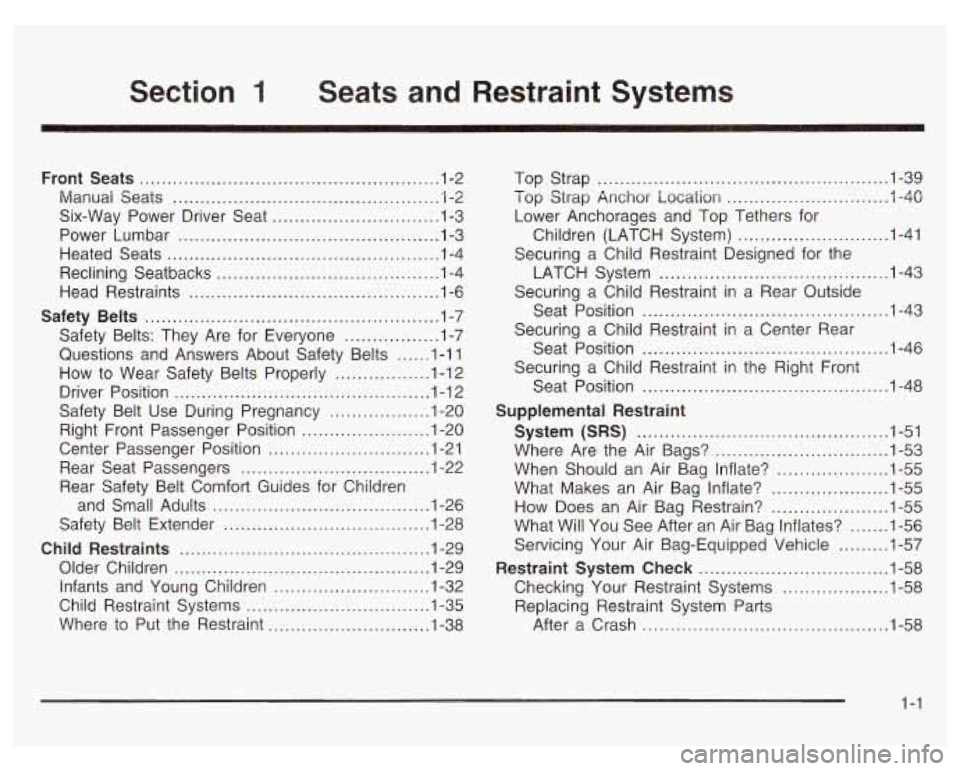
Section 1 Seats and Restraint Systems
Front Seats ...................................................... 1.2
Manual Seats
................................................ 1.2
Six-Way Power Driver Seat .............................. 1-3
Power Lumbar
............................................... 1-3
Heated Seats
................................................. 1-4
Head Restraints
............................................. 1-6
Safety Belts: They Are for Everyone
................. 1-7
Questions and Answers About Safety Belts
...... 1.11
How to Wear Safety Belts Properly
................. 1.12
Driver Position
.............................................. 1.1 2
Safety Belt Use During Pregnancy
.................. 1-20
Reclining
Seatbacks
........................................ 1-4
Safety Belts ..................................................... 1-7
Right Front Passenger Position
....................... 1-20
Center Passenger Position
............................. 1-21
Rear Seat Passengers .................................. 1-22
Rear Safety Belt Comfort Guides for Children
and Small Adults
....................................... 1.26
Safety Belt Extender
..................................... 1-28
Child Restraints ............................................. 1.29
Older Children
.............................................. 1-29
Infants and Young Children
............................ 1.32
Child Restraint Systems
................................. 1-35
Where to Put the Restraint
............................. 1-38 Top
Strap
.................................................... 1.39
Top Strap Anchor Location
............................. 1.40
Lower Anchorages and Top Tethers for
Children (LATCH System)
........................... 1.41
Securing a Child Restraint Designed for the
LATCH System
......................................... 1-43
Securing a Child Restraint in
a Rear Outside
Seat Position
............................................ 1.43
Securing a Child Restraint in a Center Rear
Seat Position
............................................ 1-46
Securing a Child Restraint in the Right Front
Seat Position
............................................ 1.48
Supplemental Restraint
System (SRS)
............................................. 1-51
Where Are the Air Bags?
............................... 1-53
When Should an Air Bag Inflate?
.................... 1-55
What Makes an Air Bag Inflate?
..................... 1-55
How Does an Air Bag Restrain?
..................... 1-55
What Will You See After an Air Bag Inflates?
....... 1.56
Servicing Your Air Bag-Equipped Vehicle
......... 1-57
Checking Your Restraint Systems ................... 1.58
Replacing Restraint System Parts
After a Crash
........................................ 1-58
Restraint System Check .................................. 1-58
Page 19 of 378
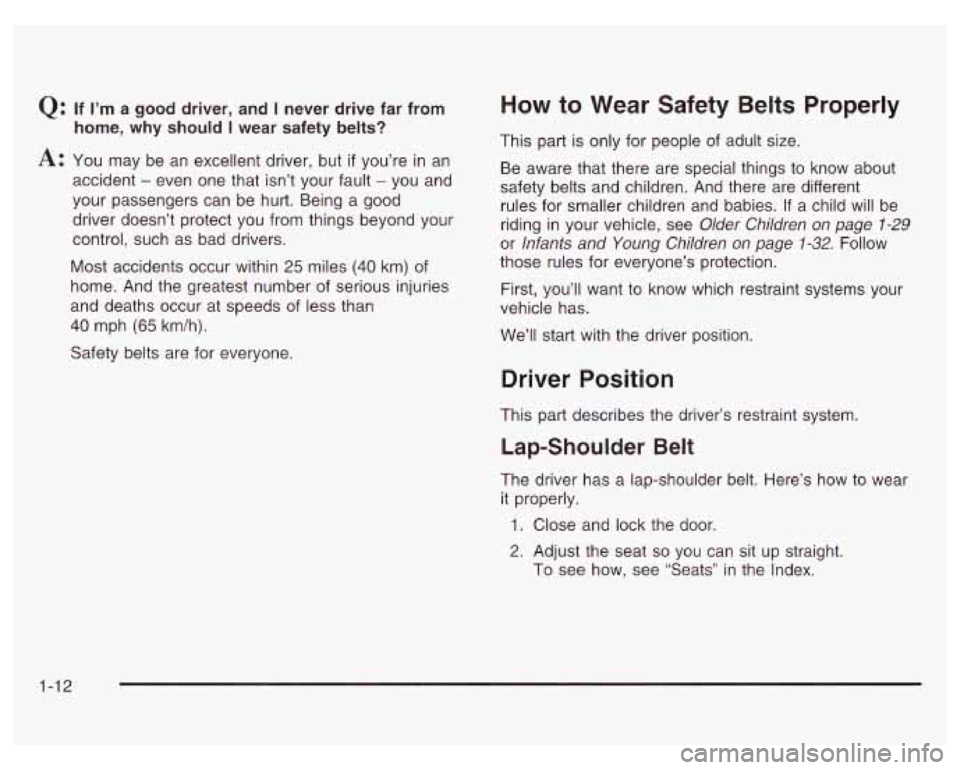
Q: If I’m a good driver, and I never drive far from
A: You may be an excellent driver, but if you’re in an
accident
- even one that isn’t your fault - you and
your passengers can be hurt. Being a good
driver doesn’t protect you from things beyond your
control, such as bad drivers.
Most accidents occur within
25 miles (40 km) of
home. And the greatest number of serious injuries
and deaths occur at speeds of less than
40 mph (65 km/h).
Safety belts are for everyone.
home, why should I wear safety belts?
How to Wear Safety Belts Properly
This part is only for people of adult size.
Be aware that there are special things
to know about
safety belts and children. And there are different
rules for smaller children and babies. If a child will be
riding in your vehicle, see Older Children on page
1-29
or Infants and Young Children on page 1-32. Follow
those rules for everyone’s protection.
First, you’ll want to know which restraint systems your
vehicle has.
We’ll start with the driver position.
Driver Position
This part describes the driver’s restraint system.
Lap-Shoulder Belt
The driver has a lap-shoulder belt. Here’s how to wear
it properly.
1. Close and lock the door.
2. Adjust the seat
so you can sit up straight.
To see how, see “Seats’’ in the Index.
1-12
Page 27 of 378
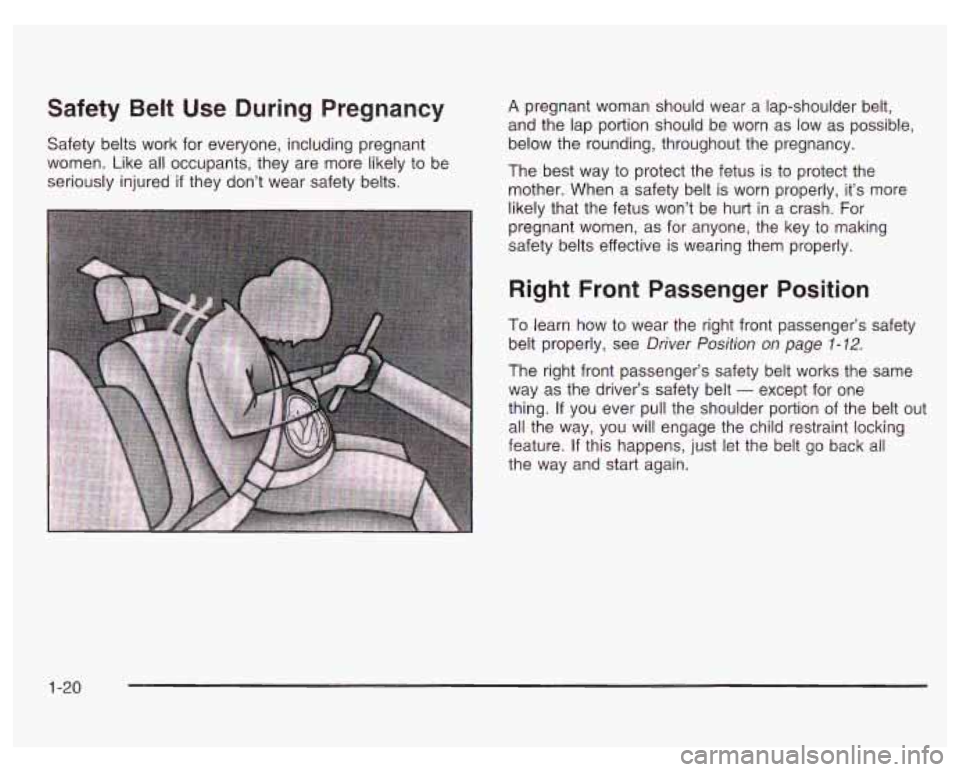
Safety Belt Use During Pregnancy
Safety belts work for everyone, including pregnant
women. Like all occupants, they are more likely to be
seriously injured
if they don’t wear safety belts.
A pregnant woman should wear a lap-shoulder belt,
and the lap portion should be worn as low as possible,
below the rounding, throughout the pregnancy.
The best way to protect the fetus is to protect the
mother. When
a safety belt is worn properly, it’s more
likely that the fetus won’t be hurt in a crash. For
pregnant women, as for anyone, the key to making
safety belts effective is wearing them properly.
Right Front Passenger Position
To learn how to wear the right front passenger’s safety
belt properly, see
Driver Position on page 7-12.
The right front passenger’s safety belt works the same
way as the driver’s safety belt
- except for one
thing.
If you ever pull the shoulder portion of the belt out
all the way, you will engage the child restraint locking
feature.
If this happens, just let the belt go back all
the way and start again.
1-20
Page 33 of 378
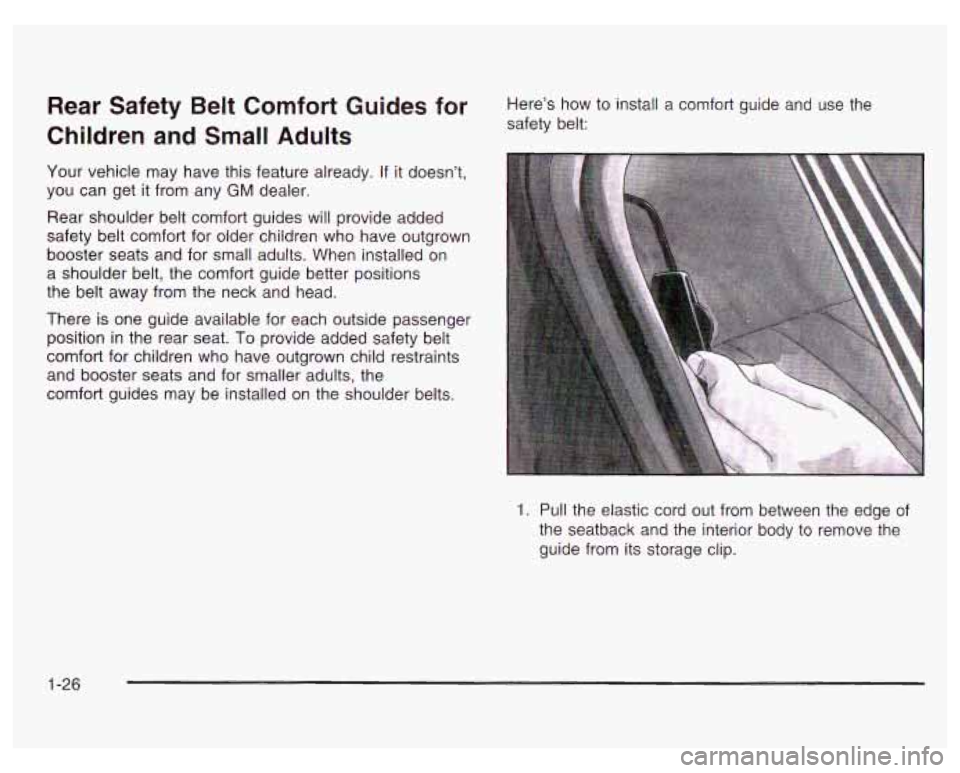
Rear Safety Belt Comfort Guides for
Children and Small Adults Here’s how to install a comfort guide and use the
safety belt:
Your vehicle may have this feature already. If it doesn’t,
you can get it from any
GM dealer.
Rear shoulder belt comfort guides will provide added
safety belt comfort for older children who have outgrown
booster seats and for small adults. When installed on
a shoulder belt, the comfort guide better positions
the belt away from the neck and head.
There is one guide available for each outside passenger
position in the rear seat. To provide added safety belt
comfort for children who have outgrown child restraints
and booster seats and for smaller adults, the
comfort guides may be installed on the shoulder belts.
1. Pull the elastic cord out from between the edge of
the seatback and the interior body to remove the
guide from its storage clip.
1-26
Page 36 of 378
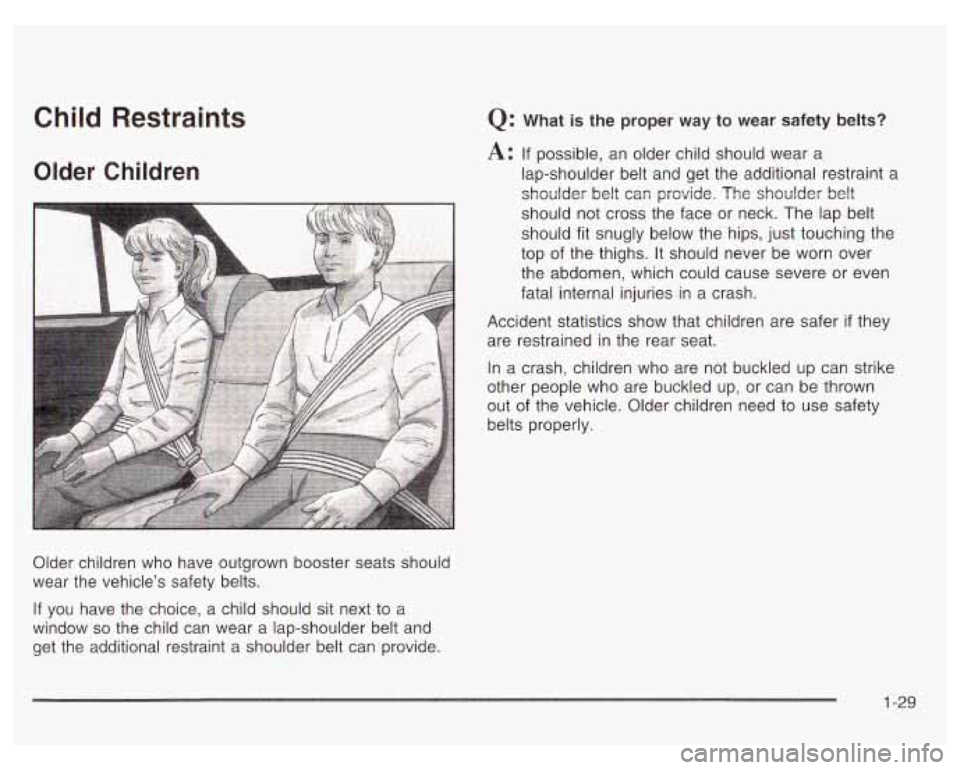
Child Restraints
Older Children
Older children who have outgrown booster seats should
wear the vehicle’s safety belts.
If you have the choice, a child should sit next to a
window
so the child can wear a lap-shoulder belt and
get the additional restraint a shoulder belt can provide.
Q: What is the proper way to wear safety belts?
A: If possible, an older child should wear a
lap-shoulder belt and get the additional restraint a
shoulder belt can provide. The shoulder
belt
should not cross the face or neck. The lap belt
should fit snugly below the hips, just touching the
top of the thighs. It should never be worn over
the abdomen, which could cause severe or even
fatal internal injuries in a crash.
Accident statistics show that children are safer
if they
are restrained in the rear seat.
In a crash, children who are not buckled up can strike
other people who are buckled up, or can be thrown
out of the vehicle. Older children need to use safety
belts properly.
1-29
Page 37 of 378
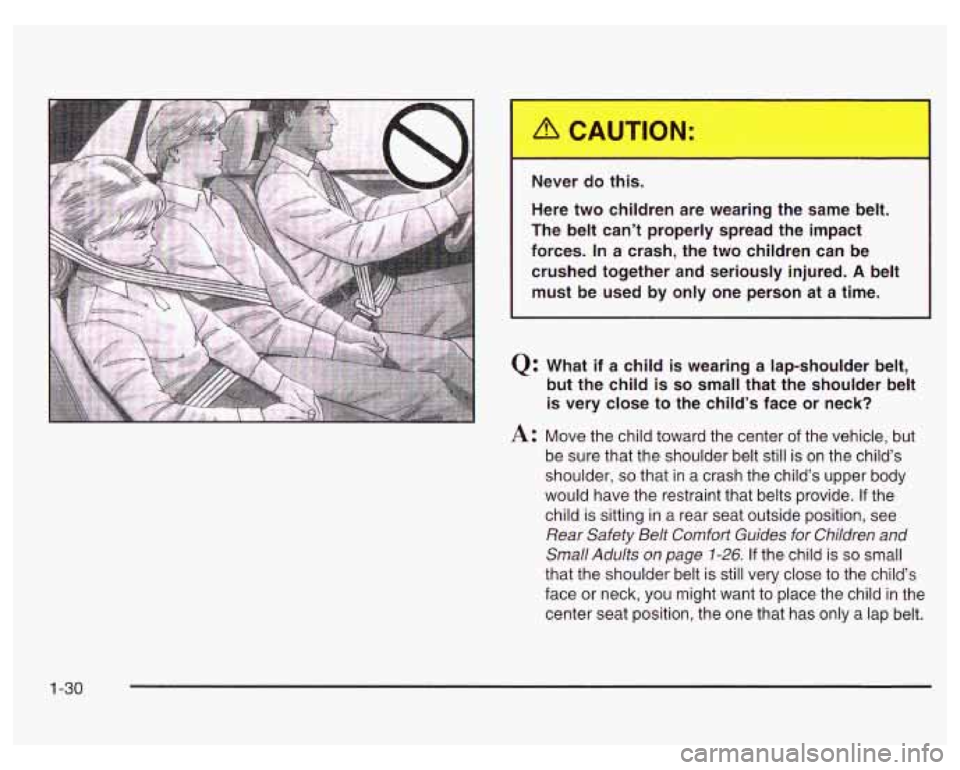
Never do this.
Here two children are wearing the same belt.
The belt can’t properly spread the impact
forces. In a crash, the two children can be crushed together and seriously injured.
A belt
must be used by only one person at a time.
Q: What if a child is wearing a lap-shoulder belt,
but the child
is so small that the shoulder belt
is very close to the child’s face or neck?
A: Move the child toward the center of the vehicle, but
be sure that the shoulder belt still is on the child’s
shoulder,
so that in a crash the child’s upper body
would have the restraint that belts provide. If the
child is sitting in a rear seat outside position, see
Rear Safety Belt Comfort Guides for Children
and
Small Adults on page 7-26. If the child is so small
that the shoulder belt is still very close to the child’s
face
or neck, you might want to place the child in the
center seat position, the one that has only
a lap belt.
1-30